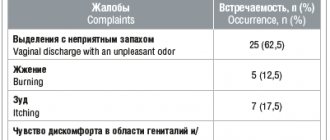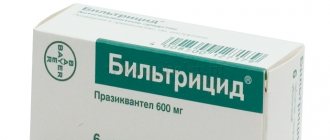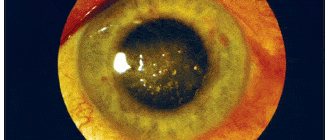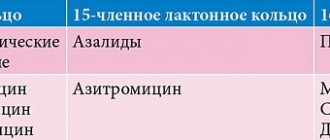Mechanism of action of H2 blockers and indications for use
Histamine (H2) cell receptors are located on the membrane inside the stomach wall. These are parietal cells, which in the body are involved in the production of hydrochloric acid.
Its excessive concentration causes disturbances in the functioning of the digestive system and leads to ulcers.
Substances contained in H2 blockers
, tend to reduce the level of gastric juice production. They also inhibit ready-made acid, the production of which is triggered by food consumption.
Blocking histamine receptors reduces the production of gastric juice and helps cope with pathologies of the digestive system.
Due to the effect they have, H2 blockers are prescribed for the following conditions:
- ulcer (both stomach and duodenum);
- stress ulcer - caused by severe somatic diseases;
- an ulcer that occurs due to long-term use of non-steroidal anti-inflammatory drugs or corticosteroids;
- acute pancreatitis and exacerbation of chronic;
- in combination with pancreatic enzyme preparations, in order to protect them from the destructive effects of gastric juice.
The dosage and duration of taking H2-antihistamine drugs for each of the listed diagnoses is prescribed individually.
“Sedative” H1 blockers
Indications
First generation antihistamines are not currently included in clinical recommendations for the treatment of allergic diseases, in particular allergic rhinitis. Their leading indication is the relief of acute allergic reactions in situations where reactions of the early phase of allergic inflammation predominate, in particular:
- acute allergic urticaria;
- allergic Quincke's edema;
- anaphylactic shock;
- acute allergic reactions to food, insect bites;
- prevention and treatment of allergies caused by drugs, etc.
Advantages
The demand for first generation H1 blockers is due to a number of their advantages compared to more modern drugs. Thus, sedative antihistamines have parenteral forms, which are advisable to administer for acute allergic reactions and emergency care, while second generation drugs are mostly produced in oral form.
Another significant difference between the first generation drugs is the ability to significantly reduce the severity of itching on the skin due to anticholinergic and sedative effects. Drugs in this group are also used for the symptomatic treatment of acute respiratory viral infections - both locally and systemically. They have been proven to help reduce nasal itching, sneezing, and nasal secretion.
First generation antihistamines also have a wide spectrum of pharmacological activity, which allows them to be used not only for allergic diseases. Thus, sedative H1 blockers are prescribed to potentiate the action of analgesics and local anesthetics (as a component of lytic mixtures); for the treatment of burns, cuts, insect bites (dimetindene maleate); as part of complex therapy for anxiety disorders (hydroxyzine); for insomnia, as well as a number of other pathological conditions, in particular, for vestibular disorders, vomiting (including in pregnant women, including the 1st trimester), migraine (doxylamine, dimenhydrinate), etc.
Portability
It should be noted that first generation H1 blockers also have a significant drawback associated with a not the highest safety profile. The side effects of these drugs are caused by their penetration through the blood-brain barrier: while taking them, lethargy, drowsiness, lack of coordination, dizziness, and decreased ability and concentration may develop. Children sometimes develop paradoxical reactions - overexcitation. Possible tachyphylaxis, side effects from the digestive system - epigastric discomfort, nausea, vomiting, increased stool frequency.
What should I warn the client about?
When dispensing sedating antihistamines with a prescription, it is important to advise the user of the drugs' ability to impair concentration and cause hypnotic effects, and to advise the user to avoid driving during treatment.
Features of the use and dosage of H2-histamine blockers
Drugs in this group are prescribed individually, based on the diagnosis and degree of development of the disease.
The dosage and duration of therapy are determined based on which group of H2 blockers is optimal for treatment.
Entering the body under the same conditions, the active ingredients of drugs of different generations are absorbed from the gastrointestinal tract in different quantities.
In addition, all components differ in efficiency.
| Active substance | Absorption when taken orally (in%) | Equivalent dosages of the substance (in mg) | Duration of suppression of hydrochloric acid production at night (in hours) | Frequency of side effects (in% of cases) |
| Cimetidine | 65-85 | 800-1000 for 3 doses per day | 2,5-5 | 3,2 |
| Ranitidine | 45-60 | 200-300 for 2-3 doses | 7-10 | 2,7 |
| Famotidine | 30-60 | 40 for 1-2 doses | 10-12 | 1,4 |
| Nizatidine | 75-100 | 300 for 1-2 doses | 10-12 | Very rarely |
| Roxatidine | 90-100 | 75-150 for 1-2 doses | 13-16 | Very rarely |
According to general recommendations, H2 blockers are contraindicated in people with hypersensitivity. They should be taken with particular caution in case of chronic heart or kidney failure, pathologies of the hematopoietic organs, as well as children under 16 years of age, pregnant and nursing mothers.
Doctor of Medical Sciences Professor E.B. Shustov, Candidate of Medical Sciences A.A. Ihalainen BLOCKERS OF H-2 HISTAMINE RECEPTORS IN CLINICAL PRACTICE
Histamine (H) receptors were discovered in 1937, after which the first antihistamines appeared.
They had an antiallergic effect, but did not reduce gastric secretion. It was only in 1972 that two types of H receptors, H-1 and H-2, were identified and the first H-2 blocker, cimetidine, was created. General characteristics of the group: Pharmacodynamics
The antiulcer activity of these drugs is due to their inhibitory effect on the secretion of hydrochloric acid due to the blockade of type 2 histamine receptors in the parietal cells of the stomach lining. The drugs suppress basal and stimulated secretion of hydrochloric acid, reduce the volume and acidity of gastric juice, and reduce the secretion of pepsin. In addition, H-2 blockers have additional mechanisms of action associated with their ability to partially increase the synthesis of prostaglandins in the gastric mucosa, which, in turn, can lead to:
- activation of blood flow in the gastric mucosa;
- increasing the synthesis of bicarbonates that neutralize hydrochloric acid in gastric juice;
- promote restoration (regeneration) of damaged epithelial cells in the area of erosion or ulcerative defect;
- possibly stimulate mucus production and increase the tone of the lower esophageal sphincter (in particular, ranitidine), which is especially important for eliminating heartburn.
Pharmacokinetics
Pharmacokinetically, H2-blockers differ in bioavailability, half-life and duration of action, and the degree of hepatic metabolism. Cimetidine is the least hydrophilic, which leads to a short half-life and significant metabolism in the liver. It interacts with the microsomal enzyme, cytochrome P-450, changing the rate of hepatic metabolism of xenobiotics. Cimetidine is a universal inhibitor of the hepatic metabolism of many drugs, due to which it can enter into pharmacokinetic interactions with other drugs, usually leading to their accumulation and increased risk of side effects. Cimetidine is better than other H-2 blockers in being able to penetrate into tissues, causing the development of side effects. It is capable of displacing endogenous testosterone from its connection with receptors, thereby causing sexual dysfunction. Ranitidine and especially famotidine, nizatidine, roxatidine penetrate less into organs and tissues, which reduces the number of side effects. These drugs do not interact with androgens and cause virtually no sexual dysfunction.
Comparative characteristics of drugs
The 1st generation includes cimetidine, the 2nd - ranitidine, the 3rd - famotidine, the 4th - nizatidine, the 5th - roxatidine.
Descriptions of the use of a new drug in this class, ebrotidine, have appeared. Ranitidine bismuth citrate stands out, which is a complex compound (and not a simple mixture) of ranitidine (base), trivalent bismuth and citrate. Ranitidine and famotidine are more selective than cimetidine. When used in high doses, cimetidine can have an effect on H-1 receptors, since selectivity is a relative and dose-dependent phenomenon. Ranitidine and famotidine act more selectively on the H-2 receptors of parietal cells. Famotidine is 40 times more powerful than cimetidine and 8 times more powerful than ranitidine. In the clinic, differences in potency are determined by data on the equivalence of doses of different H-2 blockers that act to reduce the secretion of hydrochloric acid. The strength of binding to receptors also determines the duration of action. The drug, which binds strongly to the receptor, slowly dissociates, which causes a long-lasting effect. Famotidine has the longest effect on basal secretion. Studies of intragastric pH show that an effective reduction in basal secretion is maintained after taking cimetidine for 2-5 hours, ranitidine for 7-8 hours, famotidine for 10 and even 12 hours. All H-2 blockers are hydrophilic drugs. Cimetidine is the least hydrophilic and moderately lipophilic among all H-2 blockers. This determines its ability to penetrate different organs and, acting on the H-2 receptors localized in them, cause side effects. Ranitidine and famotidine are highly hydrophilic, poorly penetrate into tissues, and have a predominant effect on H-2 receptors of parietal cells. H-2 blockers vary in tolerability, especially in cases of long-term use. The maximum number of side effects is caused by cimetidine, ranitidine and famotidine due to the changed chemical structure (cimetidine contains an imidazole group, ranitidine - a furan group, famotidine, nizatidine - a thiazole group, roxatidine - a pipedine group) give fewer side effects and do not affect the activity of liver metabolizing enzymes. Indications for use:
- ulcerative lesions of the esophageal mucosa;
- gastroesophageal reflux with and without esophagitis;
- peptic ulcer of the stomach and duodenum;
- symptomatic and medicinal, acute and chronic ulcers of the stomach and duodenum;
- chronic dyspepsia with epigastric and chest pain;
- Zollinger-Ellison syndrome;
- systemic mastocytosis;
- Mendelssohn's syndrome;
- prevention of stress ulcers;
- prevention of aspiration pneumonia;
- bleeding from the upper gastrointestinal tract;
- pancreatitis.
Dosage regimen:
A single daily dose at night is as effective as taking half doses twice (morning and evening). The drugs can also be used 4 hours before surgery before general anesthesia.
Contraindications:
- hypersensitivity to drugs of this group;
- liver cirrhosis with a history of portosystemic encephalopathy;
- liver and kidney dysfunction;
- pregnancy;
- lactation;
- children's age (up to 14 years).
Precautions
Use with caution in patients with impaired renal function. The use of drugs may mask the symptoms of stomach cancer (careful monitoring of elderly patients and patients with variable symptoms is necessary). Quickly dissolving tablets contain sodium, which must be taken into account if it is necessary to limit its intake, and aspartame, the intake of which is undesirable for patients with phenylketonuria.
Side effects
Different drugs in this group cause side effects with different frequencies. When using cimetidine it is 3.2%, ranitidine - 2.7%, famotidine - 1.3%. These include:
- headache, dizziness, drowsiness, fatigue, anxiety, agitation, depression, hallucinations, confusion, reversible visual impairment, involuntary movements;
- arrhythmias (tachycardia, bradycardia, asystole, AV blockade, extrasystole);
- constipation or diarrhea, nausea, vomiting, abdominal pain;
- acute pancreatitis;
- changes in liver function tests, hepatocellular, cholestatic or mixed hepatitis with or without jaundice;
- hypersensitivity reactions (rash, fever, arthralgia, myalgia; erythema multiforme, angioedema, anaphylactic shock);
- increased blood creatinine;
- disorders of the blood and hematopoiesis (pancytopenia, leukopenia, agranulocytosis, granulocytopenia, thrombocytopenia, bone marrow hypoplasia and aplastic anemia, immune hemolytic anemia);
- gynecomastia;
- impotence;
- decreased libido;
- alopecia.
Famotidine has side effects primarily on the gastrointestinal tract - either diarrhea or (less commonly) constipation develop. Diarrhea is the result of antisecretory action. Reducing the production of hydrochloric acid increases the pH in the stomach, which prevents the conversion of pepsinogen to pepsin, which is involved in the breakdown of food proteins. In addition, a decrease in the production of gastric juice, as well as blockade of H-2 receptors in the pancreas, cause a decrease in the secretion of digestive enzymes by the pancreas and bile. All this leads to disruption of the digestive process and the development of diarrhea. However, the frequency of these complications is low (for famotidine - 0.03-0.4%) and usually does not require discontinuation of treatment. Similar effects are characteristic of all H-2 blockers. They are dose-dependent and can be weakened by reducing the dose of the drug. H-2 blockers may cause idiosyncratic hematological side effects. They usually occur in the first 30 days of treatment, are reversible and most often manifest as thrombocytopenia and granulocytopenia. When using famotidine, they are observed in 0.06-0.32% of patients. Disruptions of the endocrine system are caused by the ability of H-2 blockers to displace endogenous testosterone from its connection with receptors, as well as medications containing this hormone, leading to sexual disorders (impotence, gynecomastia). These side effects are also dose dependent. Famotidine causes them much less frequently than cimetidine and ranitidine. H-2 blockers can disrupt the function of the cardiovascular system by blocking H-2 receptors in the myocardium and vascular wall. In those suffering from cardiovascular diseases and elderly patients, they can cause arrhythmias, increase heart failure, and provoke coronary spasm. Hypotension is sometimes observed with intravenous administration of cimetidine. Hepatotoxicity of H-2 blockers, manifested by hypertransaminasemia, hepatitis, and impaired cytochrome P-450 activity, is associated with the metabolism of H2 blockers in the liver. This is most typical for cimetidine. When using famotidine, due to its low metabolism, the frequency of such complications is minimal. Disorders of consciousness and psyche are the result of penetration of H-2 blockers through the blood-brain barrier. The degree of penetration into the central nervous system of cimetidine is 0.24, ranitidine - 0.17, famotidine - 0.12% of the drug content in the blood. Neurotropic adverse reactions occur more often in older people and with impaired liver and kidney function, as well as when the integrity of the blood-brain barrier is compromised. Their frequency is 0.05-0.1%. H-2 blockers can worsen the course of broncho-obstructive diseases, leading to bronchospasm. Allergic reactions such as urticaria are also possible. The incidence of skin rash after taking famotidine is 0.1-0.2%. A side effect common to all H-2 blockers, regardless of their pharmacokinetic properties, is the development of withdrawal syndrome. Therefore, it is recommended to reduce the dose gradually. Interactions with other pharmacological drugs: Pharmacokinetic
Possible pharmacokinetic levels of drug interactions with H-2 blockers:
- absorption in the stomach.
Due to their significant antisecretory effect, H-2 blockers can affect the pH-dependent absorption of electrolyte drugs by changing their ionization and degree of diffusion. Thus, cimetidine reduces the absorption of ketoconazole, antipyrine, aminazine, and iron supplements. To avoid possible disruption of absorption in the stomach, it is recommended to prescribe other medications 1-2 hours before taking H-2 blockers. Absorption of H-2 blockers can be reduced by up to 30% when taken together with aluminum-containing antacids, as well as sucralfate. It is advisable to use antacids 2 hours after H-2 blockers.
- hepatic metabolism
H-2 blockers are able to interact with cytochrome P-450, the main oxidative enzyme of the liver. In this case, the half-life may increase, the effect may be prolonged, and an overdose of drugs that are metabolized by more than 74% may occur. Cimetidine reacts with cytochrome P-450 10 times more strongly than ranitidine. Famotidine does not interact with it at all. Therefore, when treated with ranitidine or famotidine, there is no or very little disturbance in the hepatic metabolism of drugs. Inhibition of cytochrome P-450 function under the influence of cimetidine leads to impaired metabolism of drugs with low and high hepatic clearance. At the same time, drug clearance is reduced by an average of 20-40%, which may have clinical significance. Ranitidine and famotidine do not alter their metabolism.
- hepatic blood flow velocity
Due to the possible reduction in hepatic blood flow rate by 15-40%; Especially with intravenous use of cimetidine and ranitidine, the first-pass metabolism of drugs with high clearance may be reduced. Famotidine does not change the speed of portal blood flow.
- renal tubular excretion
H-2 blockers are weak bases and are excreted by active secretion in the renal tubules.
At this level, interactions may occur with other drugs excreted by the same mechanisms. Thus, cimetidine and ranitidine reduce the renal excretion of quinidine, procainamide, N-acetylnovocainamide to 35%. Famotidine does not alter the elimination of these drugs, possibly due to the use of different transport systems for excretion than cimetidine and ranitidine. In addition, average therapeutic doses of famotidine provide low plasma concentrations that cannot significantly compete with other drugs at the level of tubular secretion. Pharmacodynamic
Pharmacodynamic interactions of H-2 blockers with other antisecretory drugs (for example, anticholinergic drugs) may enhance therapeutic efficacy. The combination of H-2 blockers with drugs that act on Helicobacter (bismuth drugs, metronidazole, tetracycline, amoxicillin, clarithromycin) accelerates the healing of peptic ulcers. Adverse pharmacodynamic interactions have been observed with drugs containing testosterone. Cimetidine displaces the hormone from its connection with receptors and increases its concentration in the blood plasma by 20%. Ranitidine and famotidine do not have this effect.
Costs of using
Ranitidine
The price of a 21-day oral course of ranitidine (300 mg per day) ranges from 30 (Ranitidine, Hemofarm) to 100 (Zantac, Glaxo-Wellcome) rubles. Using dissolvable Zantac tablets will cost even more. The lower price range (30-50 rubles) is represented by drugs from the following companies: Hemofarm, Zdorovye (Ukraine), Moskhimfarmpreparaty, Akrikhin, Olainsky Chemical Plant; medium (50-70) - Jaka-80, Ranbaxy Labs, Torrent, Unique, KRKA, Zdravle; more than 70 rubles per course of drugs from companies: Glaxo-Wellcome, Vector, Pharmachim. A single dose of parenteral ranitidine costs from 4 (Ranitidine, Unique) to 23 (Zantac, Glaxo-Wellcome) rubles, daily from 11 to 68 rubles, respectively.
Famotidine
A three-week course of treatment with famotidine costs from 60 (Apo-Famotidine, Apotex) to 140 (Kvamatel, Gedeon Richter) rubles. The lower price range (from 60 to 70 rubles) is represented by the following drugs: Apo-Famotidine, Apotex; Gastrosidin, Eczacibasi; Famotidine, Vector; Famotidine, Hemofarm; Famotidine, Norton Healthcare; Ulfamid, KRKA; Famotidin-Akri, Akrikhin; Famocid, Sun Pharm., medium (70-80 rubles): Famosan, Pro.Med.CS. The courses of Ulceran, Medochemie and Kvamatela, Gedeon Richter are much more expensive (more than 90 rubles). A single dose of Kvamatel for parenteral use costs from 22 to 35 rubles, daily 45-70 rubles.
Cimetidine
A course of treatment with cimetidine costs from 43 (Cimetidin, Pharmacia AD) to 260 (Primamet, Lek) rubles. Cimetidine for parenteral use is presented on the market with the following drugs: Histodil, Gedeon Richter (single dose price 7.5 rubles, daily dose 30 rubles); Tagamet, SmithKline Beecham (single dose price 15 rubles, daily dose 60 rubles)
Today, for oral therapy, you essentially have to choose between the drugs Ranitidine (slightly cheaper) and Famotidine (less likely to develop side effects). The price of the course largely depends on the policy of the manufacturer. The use of cimetidine drugs, if it is possible to prescribe drugs of older generations, is not recommended. Among parenteral drugs, it is worth paying attention to ranitidine preparations. Systemic side effects with short-term use are unlikely, but famotidine has more local side effects.
Ranitidine
Ranitidine
N-[2-[[[5-[(Dimethylamino) methyl]-2-furanyl] methyl] thio] ethyl]-N`-methyl-2-nitro-1, 1-ethenediamine (as hydrochloride) Table 1. Ranitidine preparations for oral use (not shown in the online version)
Table 2. Ranitidine preparations for parenteral use (not shown in the online version)
Pharmacological characteristics
Selectively blocks type 2 histamine receptors. The duration of action of a dose of 150 mg taken orally is 12 hours. Rapidly absorbed from the gastrointestinal tract: maximum plasma concentration is achieved after 2 hours. Bioavailability is about 50% of the dose due to the first pass effect through the liver. Binds to plasma proteins by 15%. Penetrates through histohematic barriers, including the placental barrier, and poorly through the blood-brain barrier. Partially biotransformed in the liver. The half-life is 2-3 hours. About 30% of the orally and 70% of the intravenously administered dose is excreted unchanged in the urine after 24 hours. Significant concentrations are detected in breast milk. The rate and extent of elimination depend little on the condition of the liver and are mainly related to kidney function.
Contraindications
General for the group, as well as:
- porphyria.
Doses and regimens
Oral: 300 mg 1 time per day (at 19-20 hours) or 150 mg 2 times a day; for erosive esophagitis - 150 mg 4 times a day; The maximum permissible dose for adults is 6 g per day. Intramuscularly: daily dose 200 mg, 50 mg every 6 hours; Intravenously slowly: in a daily dose of 200 mg, 50 mg, diluted in 20 ml of 0.9% sodium chloride solution (administer at least 2 minutes), every 6 hours. Children: orally 2-4 mg/kg 2 times a day for stomach and duodenal ulcers (maximum 300 mg per day), for reflux esophagitis - 2-8 mg/kg 3 times a day.
Overdose
Treatment: removal of the drug from the gastrointestinal tract; for convulsions - diazepam intravenously; for bradycardia - atropine; for ventricular arrhythmias - lidocaine.
Famotidine
Famotidine
3-[[[2-[(Aminoiminomethyl) amino]-4-thiazolyl] methyl]thio]-N-(aminosulfonyl) propanimidamide Table 3. Famotidine preparations for oral use (not shown in the online version)
Table 4. Famotidine preparations for parenteral use (not shown in the online version)
Pharmacological characteristics
Selectively blocks H-2 receptors, 3rd generation drug. Despite its high antisecretory activity, famotidine does not significantly change the level of gastrin in the blood serum, which gives it important advantages over proton pump blockers. It is not completely absorbed from the gastrointestinal tract, bioavailability is 40-45%, increases under the influence of food and decreases when using antacids. Plasma protein binding is 15-20%. The maximum concentration in blood plasma is achieved after 1-3 hours. 30-35% is metabolized in the liver and excreted by the kidneys by glomerular filtration and tubular secretion. 25-30% of the dose taken orally and 65-70% of the dose administered intravenously are found unchanged in the urine. The half-life is 2.5-3 hours, and it increases in patients with renal failure. After oral administration, the effect begins within 1 hour, reaches a maximum within 3 hours and lasts 10-12 hours. Under conditions of intravenous administration, the maximum effect develops after 30 minutes. A single dose (10 and 20 mg) suppresses secretion for 10-12 hours.
Side effects
General for the group, as well as:
- dry mouth;
- noise in ears;
- conjunctivitis;
- bronchospasm;
- irritation at the injection site.
Doses and administration
Orally: 40 mg 1 time per day (at 19-20 hours) or 20 mg 2 times a day, course duration 4-8 weeks. To prevent exacerbations - 20 mg 1 time per day at night for 6 months. For reflux esophagitis - 6-12 weeks. For diseases accompanied by a pronounced hypersecretory state of the stomach (Zollinger-Ellison syndrome, systemic mastocytosis, polyendocrine adenomatosis), the daily dose can be increased to 160 mg or more, the frequency of administration is 4 times. To prevent aspiration of gastric contents before general anesthesia, 20 mg on the day of surgery, at least 2 hours before the start. Intravenously slowly: powder (20 mg) is diluted in 20 ml of 0.9% sodium chloride solution, administered every 8 hours. Intravenous drip: powder (20 mg) is diluted in 100 ml of 5% glucose solution, administered every 8 hours.
special instructions
The injection solution is prepared immediately before use.
Nizatidine
Nizatidine
N-[2-[[[[2-[(Dimethylamino) methyl]-4-thiadazolyl] methyl]thio]ethyl]-N`-methyl-2-nitro-1, 1-ethenediamine B is marketed under the name Axid by Eli Lilly, Switzerland.
Release form: capsules of 150 and 300 mg of nizatidine, ampoules containing 25 mg of nizatidine in 1 ml. Pharmacological characteristics
H-2 is a 4th generation blocker. When taken orally, it is quickly and completely absorbed. Bioavailability is about 70%. The maximum concentration in blood plasma is achieved after 0.5-3 hours. 35% of the drug contained in plasma is bound to plasma proteins. The half-life is 1-2 hours. About 60% of the dose taken is excreted unchanged in the urine, less than 6% is excreted in the feces.
Doses and regimens
Orally: for duodenal ulcers in the acute phase and gastric ulcers, 150 mg 2 times a day or 300 mg 1 time a day, in the evening; for the prevention of exacerbations - 150 mg 1 time per day, in the evening. Intravenously: dilute 300 mg in 150 ml of a compatible solution for intravenous administration, the rate of administration is 10 mg per hour or bolus, without dilution - 100 mg g (4 ml) 3 times a day. The daily dose should not exceed 480 mg. In patients with impaired renal function, the dosage regimen must be adjusted taking into account creatinine clearance.
Interaction
Against the background of large doses of aspirin, it increases the level of salicylic acid in the blood. Antacids reduce the absorption of nizatidine.
Overdose
Symptoms: lacrimation, increased salivation, vomiting, diarrhea, miosis.
Roxatidine
Roxatidine
2-Hydroxy-N-[3-[3-(1-piperidinylmethyl) phenoxy] propyl] acetamide (and as acetate or acetate hydrochloride) Available under the trade name Roxane by Hoechst Marion Roussel (Germany). Release form: extended-release film-coated tablet containing roxatidine 75 or 150 mg; There are 100 or 14 pieces in a package, respectively.
Pharmacological characteristics
Histamine H-2 receptor blocker. Pronouncedly suppresses the production of hydrochloric acid by the lining cells of the stomach. The suppression of morning secretion of gastric acid is 88% when taking 75 mg of roxatidine in the evening, and almost 100% when taking 150 mg of roxatidine. Daytime secretion decreases when taking the same doses in the evening by 35% and 44%, respectively. Roxatidine is rapidly metabolized to form active deacetyl-roxatidine. Plasma protein binding of the main metabolites is 6-7%. Two-thirds of the active substance is excreted through the kidneys, and the remaining third is biotransformed in the liver into other metabolites, which are also excreted by the kidneys. The half-life is approximately 5 hours.
Doses and regimens
For the treatment of gastric and duodenal ulcers, 75 mg of the drug is prescribed in the morning and evening or 150 mg in the evening. For patients with impaired renal function, the dosage regimen is set taking into account the values of creatinine clearance (CC). For CC from 20 to 50 ml/min, 75 mg of the drug is prescribed 1 time/day, in the evening. For CC less than 20 ml/min, 75 mg of the drug is prescribed once every 2 days, in the evening. For the prevention of gastric and duodenal ulcers, a dose of 75 mg is prescribed in the evening. The duration of treatment is determined individually. In case of exacerbation of peptic ulcer, the duration of use of the drug is on average 4 weeks, in case of esophagitis - 6 weeks. The tablets should be swallowed whole, without chewing, with plenty of water.
Interaction
Concomitant meals or antacids do not affect the absorption of Roxane. Because Roxane suppresses gastric acid secretion, the absorption of other drugs may be altered and their effects may be reduced (eg, ketoconazole) or enhanced (eg, midazolam).
Cimetidine
It is not included in the Russian Formulary Directory (Federal Guide for Doctors).
Cimetidine
N-Cyano-N`-methyl-N«-[2-[[(5-methyl-1H-imidazol-4-yl) methyl] thio] ethyl] guanidine (and hydrochloride form) Table 5. Oral preparations of cimetidine applications (not shown in the online version)
Table 6. Cimetidine preparations for parenteral use (not shown in the online version)
Doses and regimens
Orally: after meals, 0.8-1.0 g per day for 4 doses, course 4-8 weeks, maintenance therapy - 0.4 g per night for several months; withdrawal of treatment - gradually. Intravenously: 0.2 g every 4-6 hours, 0.2 g drip over 2 hours, maximum infusion rate - 0.15 g/h, possible development of cardiac arrhythmias and hypotension.
Interaction
General for the group, as well as:
- Antacids and metoclopramide reduce absorption;
- Increases the risk of developing neutropenia in combination with cytostatics;
- Reduces the effect of androgens, barbiturates (mutually);
- Increases the severity of side effects of narcotic analgesics;
- Slows down the absorption of chlorpromazine.
Ranitidine bismuth citrate Ranitidine bismuth citrate
N-[2-[[[5-[(Dimethylamino) methyl]-2-furanyl] methyl]thio]ethyl]-N`-methyl-2-nitro-1, 1-ethenediamine bismuth citrate Under the brand name Pylorid, it is produced by Glaxo-Wellcome (UK). Release form: film-coated tablet contains ranitidine bismuth citrate 400 mg; package contains 14 and 28 tablets.
Pharmacological characteristics
A complex consisting of ranitidine (base), trivalent bismuth and citrate in a weight ratio of 81:64:55. In the stomach, the drug dissociates into individual components. Shows a combined antiulcer effect: ranitidine blocks H-2 receptors of the parietal cells of the stomach; bismuth citrate has a protective (astringent) effect on the gastric mucosa and is bactericidal against Helicobacter pylori. Like other bismuth preparations, Pilorid prevents the development of antibiotic-resistant strains during treatment. The rate and extent of absorption of ranitidine is proportional to the dose (range up to 1600 mg). The maximum concentration of ranitidine in plasma is achieved after 0.5-5 hours. Bismuth absorption is variable (less than 1% of the administered dose) - it decreases by 50% (rapidity) and 25% (completeness) when taken 30 minutes before meals and increases with increasing (above 6) intragastric pH. The maximum concentration is determined after 15-60 minutes, does not change in the dose range of 400-800 mg and does not increase proportionally at doses above 800 mg. Bismuth accumulates in plasma, equilibrium concentration is achieved after 4 weeks of treatment. The half-life of bismuth is 11-28 days, binding to proteins is 98%, less than 1% of the dose is excreted in urine, and 28% in feces in 6 days. Elimination of both components is determined by renal function and does not depend on the condition of the liver. Equal inhibition of the level of gastric secretion was shown when using ranitidine hydrochloride at a dose of 150 mg and Piloride at a dose of 391 mg. These doses contain equivalent amounts of ranitidine. In the treatment of peptic ulcer associated with Helicobacter pylori, the combination of Pilorid with antibiotics causes maximum eradication of the infection, which promotes rapid healing of the peptic ulcer and prolongs the remission of the disease.
Indications:
- peptic ulcer of the stomach and duodenum;
- eradication of Helicobacter pylori;
- prevention of relapses of peptic ulcers caused by Helicobacter pylori (in combination with clarithromycin or amoxicillin).
Dosage regimen
In the first 2 weeks - 400 mg 2 times a day in combination with clarithromycin (500 mg 2 times a day), the next 2 weeks - ranitidine bismuth citrate 400 mg 2 times a day, regardless of meals.
Interaction
Penicillins (amoxicillin) and macrolides (clarithromycin) enhance (mutually) the bactericidal effect of bismuth (against Helicobacter pylori). Clarithromycin increases the absorption of ranitidine. The use of Pilorid may enhance the bactericidal activity of clarithromycin against Helicobacter pylori strains that are already resistant to antibiotics. Food causes a decrease in bismuth absorption, which does not affect the clinic, and Pilorid can be taken with or without food.
Overdose
Symptoms: manifestations of bismuth neuro- or nephrotoxicity. Treatment: removal of unabsorbed amounts from the gastrointestinal tract, symptomatic therapy. Ranitidine and bismuth are removed from the blood by hemodialysis.
special instructions
Under the influence of bismuth, temporary darkening of the tongue and blackening of feces occurs.
Table 7. H-2 histamine receptor blockers presented on the pharmaceutical market, taking into account the cost at retail prices (not shown in the online version)






![Table 1. Comparison of the results of treatment with Tribestan for men with oligoasthenozoospermia [7] with mod.](https://laram-halal.ru/wp-content/uploads/tablica-1-sravnenie-rezultatov-lecheniya-tribestanom-muzhchin-s-oligoastenozoospermiej-7-330x140.jpg)
